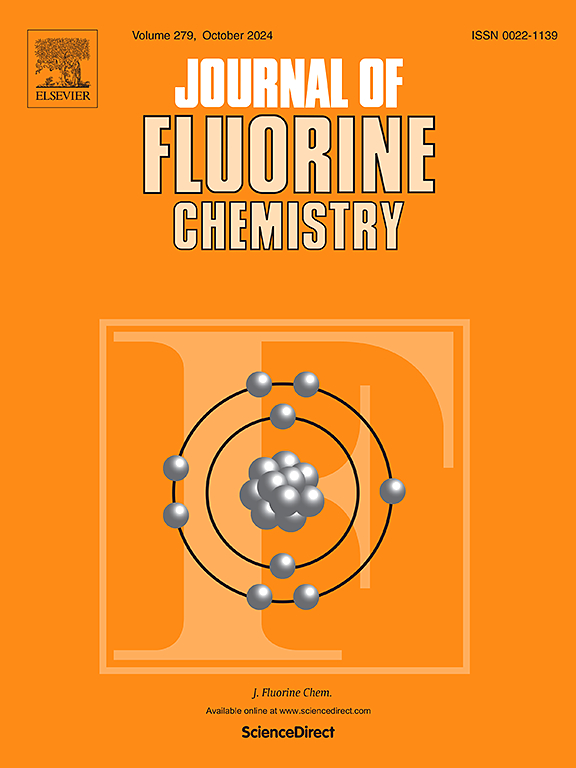1,1,2,2,3,3,4,4-辛氟-4-[(1,2,2-三氟乙烯基)氧]丁烷磺酰氟的合成
IF 1.7
4区 化学
Q3 CHEMISTRY, INORGANIC & NUCLEAR
引用次数: 0
摘要
采用相同的市售试剂,但使用顺序不同的方法,从I(CF2)4I合成短侧链全氟聚合物电解质膜原料CF2CFO(CF2)4SO2F (SSC单体),研究了两种合成路线(A:先合成CF2CFO基团,再合成SO2F基团,B:先合成SO2F基团,再合成CF2CFO基团,B:先合成SO2F基团,B:先合成cf2f基团,B:先合成cf2f基团,B:先合成cf2f基团,B:先合成cf2f基团,B:先合成cf2f基团,B:先合成cf2f基团,B:先合成cf2f基团,B:先合成cf2f基团,B:先合成cf2f基团,B:先合成cf2f基团。在路线A中,在SSC单体合成的后半程生成了副产物[CF2CFO(CF2)4I]和推测具有CF2SO2F结构的化合物,但它们很难从SSC单体中去除。另一方面,在B路线中,合成SSC单体前半部分形成的副产物I(CF2)4I很容易通过与发油的转化去除。此外,I(CF2)4I与Na2S2O4反应生成I(CF2)4SO2Na和NaO2S(CF2)4SO2Na,通过乙酸乙酯萃取操作分离,NaO2S(CF2)4SO2Na在NaI存在下经氯气转化为I(CF2)4I。我们选择路线B,得到了高纯度的SSC单体。本文章由计算机程序翻译,如有差异,请以英文原文为准。
![Synthesis of 1,1,2,2,3,3,4,4-octafluoro-4-[(1,2,2-trifluoroethenyl)oxy]butanesulfonyl fluoride](https://img.booksci.cn/booksciimg/2025-5/102304316501780116358.jpg)
Synthesis of 1,1,2,2,3,3,4,4-octafluoro-4-[(1,2,2-trifluoroethenyl)oxy]butanesulfonyl fluoride
We investigated two synthetic routes (Route A: first synthesis of the CF2![]() CFO group and then the SO2F group, Route B: first synthesis of the SO2F group and then the CF2
CFO group and then the SO2F group, Route B: first synthesis of the SO2F group and then the CF2![]() CFO group) to synthesize CF2
CFO group) to synthesize CF2![]() CFO(CF2)4SO2F (SSC monomer), the raw material for the short-side-chain perfluorinated polymer electrolyte membrane, from I(CF2)4I using the same commercially available reagents but in different order of use. In Route A, by-products [CF2
CFO(CF2)4SO2F (SSC monomer), the raw material for the short-side-chain perfluorinated polymer electrolyte membrane, from I(CF2)4I using the same commercially available reagents but in different order of use. In Route A, by-products [CF2![]() CFO(CF2)4I and the compound presumed to have the structure of CF2SO2F] were formed in the second half of the synthesis of SSC monomer, but they were difficult to remove from SSC monomer. On the other hand, in Route B, by-product I(CF2)4I formed in the first half of the synthesis of SSC monomer was easily removed by the conversion with oleum. In addition, the reaction of I(CF2)4I with Na2S2O4 produced I(CF2)4SO2Na and NaO2S(CF2)4SO2Na, which were separated by the extraction operation with ethyl acetate, and NaO2S(CF2)4SO2Na was converted to I(CF2)4I by chlorine gas in the presence of NaI. We chose Route B and obtained high-purity SSC monomer.
CFO(CF2)4I and the compound presumed to have the structure of CF2SO2F] were formed in the second half of the synthesis of SSC monomer, but they were difficult to remove from SSC monomer. On the other hand, in Route B, by-product I(CF2)4I formed in the first half of the synthesis of SSC monomer was easily removed by the conversion with oleum. In addition, the reaction of I(CF2)4I with Na2S2O4 produced I(CF2)4SO2Na and NaO2S(CF2)4SO2Na, which were separated by the extraction operation with ethyl acetate, and NaO2S(CF2)4SO2Na was converted to I(CF2)4I by chlorine gas in the presence of NaI. We chose Route B and obtained high-purity SSC monomer.
求助全文
通过发布文献求助,成功后即可免费获取论文全文。
去求助
来源期刊

Journal of Fluorine Chemistry
化学-无机化学与核化学
CiteScore
3.80
自引率
10.50%
发文量
99
审稿时长
33 days
期刊介绍:
The Journal of Fluorine Chemistry contains reviews, original papers and short communications. The journal covers all aspects of pure and applied research on the chemistry as well as on the applications of fluorine, and of compounds or materials where fluorine exercises significant effects. This can include all chemistry research areas (inorganic, organic, organometallic, macromolecular and physical chemistry) but also includes papers on biological/biochemical related aspects of Fluorine chemistry as well as medicinal, agrochemical and pharmacological research. The Journal of Fluorine Chemistry also publishes environmental and industrial papers dealing with aspects of Fluorine chemistry on energy and material sciences. Preparative and physico-chemical investigations as well as theoretical, structural and mechanistic aspects are covered. The Journal, however, does not accept work of purely routine nature.
For reviews and special issues on particular topics of fluorine chemistry or from selected symposia, please contact the Regional Editors for further details.
 求助内容:
求助内容: 应助结果提醒方式:
应助结果提醒方式:


